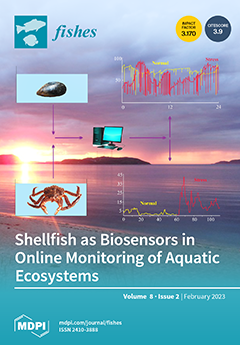The potential effects of dietary supplementation with β-1,3 glucan and fructooligosaccharides (β-1,3 GF) on antioxidant activities, immunological response, and growth performance of Pacific white shrimp (
Litopenaeus vannamei) was investigated. Four diets (iso-energetic and iso-nitrogenous) with different levels of β-1,3 GF (0,
[...] Read more.
The potential effects of dietary supplementation with β-1,3 glucan and fructooligosaccharides (β-1,3 GF) on antioxidant activities, immunological response, and growth performance of Pacific white shrimp (
Litopenaeus vannamei) was investigated. Four diets (iso-energetic and iso-nitrogenous) with different levels of β-1,3 GF (0, 0.5, 1.0, and 1.5 g kg
−1) were fed to healthy shrimp juveniles weighing 3 ± 0.5 g for 75 days. Shrimps were randomly distributed into 12 net enclosures at a density of 30 shrimp/net, and the experiment was performed in triplicate. The results revealed that long-term supplementation with 1.5 g kg
−1 β-1,3 GF significantly improved shrimp weight gain, feed conversion ratio, and digestive enzyme profiles compared to the control diet group. However, there were no substantial variations in the contents of moisture, crude protein, total lipids, and ash in the muscles of shrimp fed on different diets. Surprisingly, all antioxidants (superoxide dismutase, catalase, glutathione peroxidase) and immune biomarkers (lysozyme, total hemocyte count, phenol oxidase, and respiratory burst) activities were significantly elevated with increasing levels of β-1,3 GF in the shrimp diet, and the highest values were recorded in the 1.5 g kg
−1 diet groups. Challenge test results revealed that
F. solani could cause a high mortality rate (86.7%) in a group fed a normal basal diet within 14 days at a dose of 5 × 10
4 conidia mL
−1. Surprisingly, all dietary treated groups with different doses of β-1,3 GF showed high resistance against
F. solani, represented by lower cumulative mortality rates (20–43.3%) compared to the control group. Moreover, most of the infected shrimp showed a typical black to brown gill lesion similar to that observed in the natural infection, where an identical fungus was successfully re-isolated from infected gills and muscles. Overall, this study recommends an appropriate incorporation level of β-1,3 GF that could enhance growth performance and improve the antioxidant activities, non-specific immunity, and disease resistance of
L. vannamei, with an optimal level of 1.5 g kg
−1.
Full article





